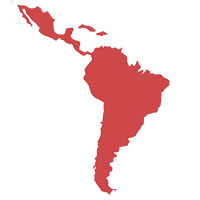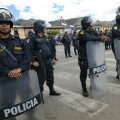Lima Shines for Climate March
Sarah Brady | December 11, 2014.
Descending on central Lima yesterday, thousands of people took part in the People’s Summit Climate March in defence of mother earth and to raise awareness of climate change across Latin America.
In a rare appearance, the Lima sun shone light on the biggest-ever environmental demonstrations to take place in the continent’s history with close to 20,000 people participating. The march was held parallel to the UN climate talks, where negotiators are tasked with producing an international legally-binding treaty to reduce carbon emissions.
Marchers arrived from many walks of life including representatives from Indigenous peoples to trade unions, traditional environmental activists and rural communities: proving once again that climate change really is everyone’s issue.
The event exceeded expectations, explained Ibis Fernandez of the march coordinating committee: “This is a record for Peru, and for us, the hosts of civil society here. We have managed to join the voices of movements and resistances both globally and nationally. After a long time, after the mobilisations we made during the time of Fujimori in the ’90s, this has been one of the principal marches we have had.”
The procession was broken into blocks for transnational NGOs like Amnesty International and WWF, to local community organisations within Peru and other Latin American countries, each with their own climate issues to voice.
Marcos Saraca, from Peru’s National Mining Federation was said he was marching today because he works at a formal mine in Peru but is concerned that there are: “Lots of informal mines who do not have environmental regulations. We are trying to raise awareness so that can change.”
Marching on behalf of Mujeres Organizadas en Comedores Populares Autogestionarios de Lima, Maria Cecilia Apashinasi said: “The earth is not producing like it once did. We do not want to lose the resources we once depended on to live. As mothers we need to guarantee food for our children.”
New York City set the precedent for record-breaking climate marches earlier this year with 400,000 people attending in September before the Climate Summit. Fernandez reflects: “We cannot compare this march with the one in New York, because we have not received the same level of funding or organising support. This has been an austere People’s Summit, but for us it has been massive.” The strong presence of community groups from all regions of Peru and the continent reflect the real present-day trials of climate change, and the desire of these communities to voice their concerns.
Large demonstrations and protests, while essential to how Latin America approaches political participation, are uncommon in Peru, given the country’s recent history of violence and a current environment of protest criminalisation.
Rosa Guillen of the feminist organisation World March of Women explains: “Successive governments have tried to criminalise our struggles, calling us terrorists and accusing us of destroying our own resources. Resistance to this reality is part of the reason we have had such a large mobilization here today. It is no coincidence that we have such a strong presence of people from Cajamarca, sisters and brothers from Puno and Cusco, regions where there is a large resistance to transnational extraction corporations.”
Fernandez believes that: “This march has been an important mile marker for Peru, and made all the more so by the agenda. Today’s turnout marks the permanent installation of climate change in the agenda of workers, unions, farmers, indigenous people, women, and other affected communities. Our country is diverse: multi-racial, multi-lingual, and multi-cultural. That diversity makes it hard for us to come together in a unified way. But today we have build the base of a new alliance.”
There was no force strong enough, except perhaps the Lima traffic, to dishearten the activists. The cross-cutting nature of the problems caused or exacerbated by climate change united people in the hope of a common solution.
Co-written with Sydney Pead.













comment